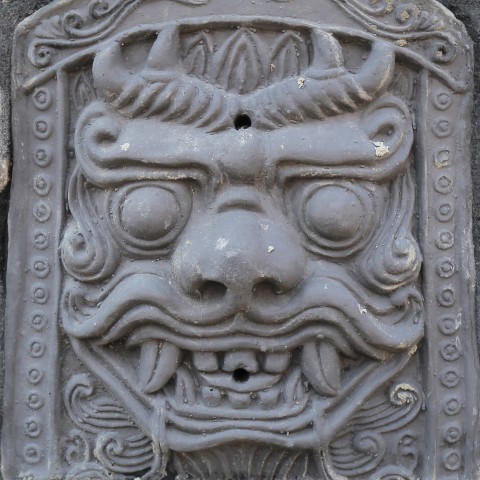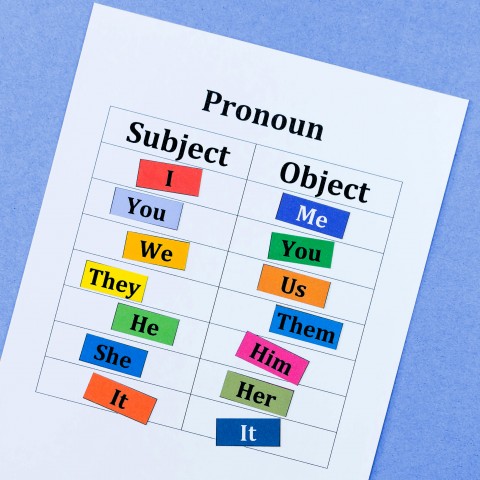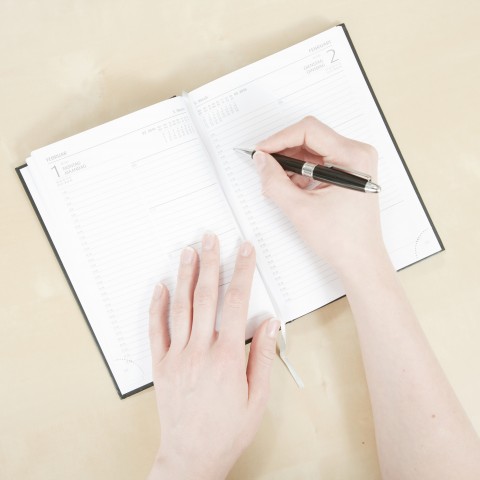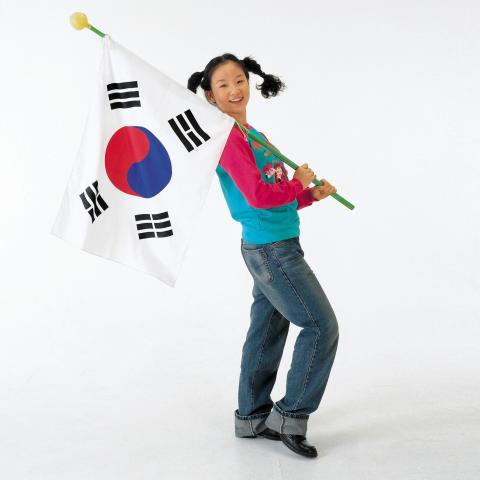
Verbs allow you to make complete sentences and describe actions or other motion-related concepts. In this Korean verbs lesson, you’ll learn 100 key Korean verbs that you’ll hear over and over again in Korea. After studying our Korean basic verbs list, be sure to hold onto it so you can refer to it when needed.
Ready to start using everyday Korean verbs? Let’s get started.
 Table of Contents
Table of Contents
- Korean Verb Grouping According to Ending Syllables
- Korean Action Verbs
- Helping Verbs
- How KoreanClass101 Can Help You with Your Korean
1. Korean Verb Grouping According to Ending Syllables

Before jumping into this Korean verbs list, let’s take a look at basic verb forms in the following Korean verbs chart. If you’re an absolute beginner, these are very fundamental verb forms that you need to remember. And if you’re familiar with them already, you can simply skip this section or check out some of the pages we listed below for further study.
A. Basic Korean Verb Forms #1
| Korean Verb Forms | Korean Verb Structure |
|---|---|
| Formal Ending | ㅂ니다 / 습니다 |
| Polite Ending | 어요 / 아요 |
| Casual Ending | 어 / 아 |
B. Basic Korean Verb Forms #2
| Korean Verb Forms | Dictionary Form | Romanization | English |
|---|---|---|---|
| Present | 가다 | gada | go |
| Past | 갔다 | gatda | went |
Check out these pages to learn more about Korean verbs with English translations:
- Past Tense: Uncover the Secrets of Your Past in Korean!
- The Past Tense Particles
- I Did it, I’m Doing it, and I’m Going To Do it
- You Went to the Library and Learned More About Your Korean Past?

2. Korean Action Verbs

1 – Korean Verbs Related to Physical Actions
* Click on a word to listen to it and practice its pronunciation.
1. 가다 (gada), “to go”
- 어디로 가고 싶어요?
Eodiro gago sipeoyo?
“Where do you want to go?”
2. 가지다 (gajida), “to have”
- 지금 가진 돈 얼마 있어요?
Jigeum gajin don eolma isseoyo?
“Do you have any money with you?”
3. 만들다 (mandeulda), “to make”
- 지금 음식을 만들고 있어요.
Jigeum eumsigeul mandeulgo isseoyo.
“I am making some food.”
4. 보다 (boda), “to look”
- 지민은 수연을 뚫어지게 보았다.
Jimineun suyeoneul ttureojige boatda.
“Jimin looked intensely at Suyeon.”
5. 말하다 (malhada), “to tell”
- 다시 한 번 말해 줄래요?
Dasi han beon malhae jullaeyo?
“Can you tell me one more time?”
6. 일하다 (ilhada), “to work”
- 공장에서 하루 종일 일했어.
Gongjangeseo haru jongil ilhaesseo.
“I worked in the factory all day.”
7. 묻다 (mutda), “to ask”
- 나한테 묻지 말아줄래?
Nahante mutji marajullae?
“Can you not ask me a question?”
8. 움직이다 (umjigida), “to move”
- 사진을 찍을 테니 움직이지 마.
Sajineul jjigeul teni umjigiji ma.
“Don’t move, I’m taking a picture.”
9. 멈추다 (meomchuda), “to stop”
- 눈물이 멈추지 않았어.
Nunmuri meomchuji anasseo.
“The tears didn’t stop running.”
10. 고치다 (gochida), “to repair”
- 철수는 하루종일 노트북을 고치는데 시간을 보냈다.
Cheolsuneun harujongil noteubugeul gochineunde siganeul bonaetda.
“Cheolsu spent the whole day fixing his laptop.”
11. 그리다 (geurida), “to draw”
- 저는 그림 그리기를 좋아해요.
Jeoneun geurim geurigireul joahaeyo.
“I like drawing.”
12. 끊어지다 (kkeuneojida), “to get cut”
- 어라? 실이 끊어져버렸네.
Eora? Siri kkeuneojyeobeoryeonne.
“Oh no, the thread has been cut off.”
13. 낳다 (nata), “to give birth to”
- 오늘 우리집 강아지가 새끼를 낳았어.
Oneul urijip gangajiga saekkireul naasseo.
“My dog gave birth to puppies today.”
14. 늦다 (neutda), “to be late”
- 미안, 30분 정도 늦을 것 같아.
Mian, 30bun jeongdo neujeul geot gata.
“Sorry, I will be late for another thirty minutes.”
15. 도망치다 (domangchida), “to run away”
Jombida! Domangchyeo!
“Zombies! Run!”
16. 돕다 (dopda), “to help”
- 제가 뭐 도울 일이라도 있나요?
Jega mwo doul irirado innayo?
“Can I be of help in any way?”
17. 때리다 (ttaerida), “to hit”
- 왜 그때 저를 때렸어요?
Wae geuttae jeoreul ttaeryeosseoyo?
“Why did you hit me that time?”
18. 발표하다 (balpyohada), “to announce”
- 내가 좋아하는 작가가 신작을 발표했어.
Naega joahaneun jakgaga sinjageul balpyohaesseo.
“My favorite author announced his new piece of work.”
19. 싸우다 (ssauda), “to fight”
- 무엇 때문에 싸우세요?
Mueot ttaemune ssauseyo?
“What are you two fighting about?”
20. 여행하다 (yeohaenghada), “to travel”
- 다음주에 한국으로 여행하러 갈 거야.
Daeumjue hangugeuro yeohaenghareo gal geoya.
“I’m going to travel to Korea next week.”
21. 흔들다 (heundeulda), “to shake”
- 오늘은 광복절이기 때문에 나는 자랑스럽게 태국기를 흔들었다.
Oneureun gwangbokjeorigi ttaemune naneun jarangseureopge taegukgireul heundeureotda.
“Because today is Korea’s National Liberation Day, I waved the Korean flag with pride.”
22. 먹다 (meokda), “to eat”
- 남자 아이는 핫도그를 먹고 있습니다.
Namja aineun hattogeureul meokgo itsseumnida.
“The boy is eating a hot dog.”
23. 사용하다 (sayonghada), “to use”
- 프로그래머가 컴퓨터를 사용하고 있다.
Peurogeuraemeoga keompyuteoreul sayonghago itta.
“The programmer is using the computer.”
24. 오다 (oda), “to come”
- 맛있는 저녁 먹으러 저희 집에 오세요.
Masinneun jeonyeok meogeureo jeohui jibe oseyo.
“Come over to my house for a nice dinner.”
25. 마시다 (masida), “to drink”
- 마실 것 좀 드릴까요?
Masil geot jom deurilkkayo?
“Can I get you something to drink?”
26. 자다 (jada), “to sleep”
- 조용! 아기들이 자고 있어요.
Joyong! Agideuri jago isseoyo.
“Shh! The babies are sleeping.”
27. 물어보다 (mureoboda), “to ask”
- 너한테 좀 물어볼 말이 있어.
Neohante jom mureobol mari isseo.
“I have some questions to ask you.”
28. 달리다 (dallida), “to run”
- 보람이는 해변에서 달리고 있습니다.
Boramineun haebyeoneseo dalligo itseumnida.
“Boram is running on the beach.”
29. 집다 (jipda), “to pick (up)”
- 우와, 저기 봐봐. 사람들이 딸기를 집고 있어.
Uwa, saramdeuri ttalgireul jipgo isseo.
“Wow, look. The people are picking the strawberries.”
30. 주다 (juda), “to give”
- 웨이터에게 팁을 5달러 줬어요.
Weiteoege tibeul odalleo jwosseoyo.
“I gave a five-dollar tip to the waiter.”
31. 떠나다 (tteonada), “to leave”
- 우린 내일 한국 떠나.
Urin naeil hanguk tteona.
“We are leaving Korea tomorrow.”
32. 놀다 (nolda), “to play”
- 아기가 장난감을 가지고 놀고 있어요.
Agiga jangnangameul gajigo nolgo isseoyo.
“The baby is playing with a toy.”
33. 시작하다 (sijakada), “to begin”
- 회의는 오전 10시에 시작됩니다.
Hoeuineun ojeon yeolsie sijakdoemnida.
“The meeting begins at ten A.M.”
34. 기다리다 (gidarida), “to wait”
- 여기서 한시간이나 기다렸어요.
Yeogiseo hansiganina gidaryeosseoyo.
“I’ve been waiting here for an hour.”
35. 전화하다 (jeonhwahada), “to call”
- 무슨일 생기면 저한테 전화주세요.
Museunil saenggimyeon jeohante jeonhwajuseyo.
“If something happens, just give me a call.”
36. 요리하다 (yorihada), “to cook”
- 지금 요리하고 있어요.
Jigeum yorihago isseoyo.
“I am cooking right now.”
37. 사다 (sada), “to buy”
- 아내에게 반지를 사 주었다.
Anaeege banjireul sa jueotda.
“I bought a ring for my wife.”
38. 운전하다 (unjeonhada), “to drive”
- 회사에 갈 때 항상 운전하고 있어요.
Hoesae gal ttae hangsang unjeonhago isseoyo.
“I always drive to work.”
39. 걷다 (geotda), “to walk”
- 매일 걸어서 학교에 가요.
Maeil georeoseo hakgyoe gayo.
“I walk to school everyday.”
40. 조사하다 (josahada), “to investigate”
- 그 이유를 조사해보니까..
Geu iyureul josahaebonikka..
“I researched about this and…”
41. 졸업하다 (joreopada), “to graduate”
- 9월에 졸업했어요.
Guwore joreopaesseoyo.
“I graduated in September.”
42. 진행되다 (jinhaengdoeda), “to progress”
- 진행될 때마다 연락주세요.
Jinhaengdoel ttaemada yeollakjuseyo.
“Please update me as you progress on this.”
43. 채우다 (chaeuda), “to fill”
- 병에 물을 채우다.
byeonge mureul chaeuda.
“Fill a bottle with water.”
44. 쳐다보다 (chyeodaboda), “to stare”
- 그만 좀 쳐다봐?
Geuman jom chyeodabwa?
“Can you just stop staring at me?”
45. 흔들다 (heundeulda), “to shake”
- 파티에서 리듬에 맞춰 몸을 흔들었다.
Patieseo rideume matchwo momeul heundeureotda.
“I shook (danced) my body to the rhythm at the party.”
46. 흘리다 (heullida), “to spill”
- 실수로 물을 흘렸어요.
Silsuro mureul heullyeosseoyo.
“I spilled the water by mistake.”
47. 선택하다 (seontaekada), “to choose”
- 선택은 당신의 자유입니다.
Seontaegeun dangsinui jayuimnida.
“The choice is yours.”

2 – Korean Verbs Related to Mental State
* Click on a word to listen to it and practice its pronunciation.
48. 알다 (alda), “to know”
- 이 곳 지리를 잘 아세요?
I got jirireul jal aseyo?
“Do you know this area well?”
49. 생각하다 (saenggakada), “to think”
- 생각할 시간이 필요해요.
Saenggakal sigani piryohaeyo.
“I need some time to think.”
50. 원하다 (wonhada), “to want”
- 크리스마스 선물로 BTS 콘서트 티켓 갖고 싶어요.
Keuriseumaseu seonmullo BTS konseoteu tiket gatgo sipeoyo.
“I want a BTS concert ticket for my Christmas present.”
51. 믿다 (mitda), “to believe”
- 전 불교를 믿고 있어요.
Jeon bulgyoreul mitgo isseoyo.
“I believe in Buddhism.”
52. 기대하다 (gidaehada), “to expect”
시험 성적이 좋기를 기대하고 있어요.
Siheom seongjeogi jokireul gidaehago isseoyo.
“I’m expecting good results for the exam.”
53. 이해하다 (ihaehada), “to understand”
- 너의 입장도 충분히 이해해.
Neoui ipjangdo chungbunhi ihaehae.
“I understand your situation completely.”
54. 좋아하다 (joahada), “to like”
- 오빠를 많이 좋아해요.
Oppareul mani joahaeyo.
“I like you a lot, Oppa.”
55. 사랑하다 (saranghada), “to love”
- 나 사랑해?
Na saranghae?
“Do you love me?”
56. 기억하다 (gieokada), “to remember”
- 그 일 기억하니?
Geu il gieokani?
“Do you remember it?”
57. 기뻐하다 (gippeohada), “to rejoice” / “to be happy”
- 부모님이 무척 기뻐하시겠어요.
Bumonimi mucheok gippeohasigesseoyo.
“Your parents must be very happy.”
58. 기억나다 (gieongnada), “to remember”
- 아 그때 그랬지, 기억났다!
A geuttae geuraetji, gieongnatda!
“Ah right, I just remembered!”
59. 노력하다 (noryeokada), “to endeavor”
- 노력할게.
Noryeokalge.
“I will work hard.”
60. 느끼다 (neukkida), “to feel”
- 순간 배신감을 느꼈어.
Sungan baesingameul neukkyeosseo.
“For a second, I felt a sense of betrayal.”
61. 닮다 (damda), “to resemble”
- 두 사람 닮지 않았어?
du saram damji anasseo?
“Don’t they resemble each other?”
62. 무시하다 (musihada), “to ignore”
- 제가 보낸 이메일은 그냥 무시하세요.
Jega bonaen imeireun geunyang musihaseyo.
“Please disregard the email that I sent to you.”
63. 미워하다 (miwohada), “to hate”
- 아직도 그 사람이 미워요?
Ajikdo geu sarami miwoyo?
“Do you still hate him?”
64. 받아들이다 (badadeurida), “to accept”
- 여자친구의 비판은 받아들이기 힘들어.
Yeojachinguui bipaneun badadeurigi himdeureo.
“I found my girlfriend’s criticisms hard to take (accept).”
65. 발전하다 (baljeonhada), “to develop”
- 그 두 사람은 친구에서 연인 사이로 빨리 발전했어.
Geu du sarameun chingueseo yeonin sairo ppalli baljeonhaesseo.
“They instantly became lovers after being friends.”
66. 비교하다 (bigyohada), “to compare”
- 나를 다른사람들과 비교하지마.
Nareul dareunsaramdeulgwa bigyohajima.
“Don’t compare me to other people.”
67. 확인하다 (hwaginhada), “to check” / “to confirm”
- 잠시만요, 확인해볼께요.
Jamsimanyo, hwaginhaebolkkeyo.
“Hold on, let me check it for you.”
68. 화나다 (hwanada), “to be angry”
- 날 화나게 하지마.
Nal hwanage hajima.
“Don’t make me angry.”
69. 필요하다 (piryohada), “to need”
- 도움이 필요합니다.
Doumi piryohamnida.
“I need help.”
70. 시달리다 (sidallida), “to suffer from”
- 불면증에 시달리고 있어.
Bulmyeonjeunge sidalligo isseo.
“I’m suffering from insomnia.”
71. 감사하다 (gamsahada), “to be thankful”
- 호의에 감사드립니다.
Houie gamsadeurimnida.
“Thanks for your kindness.”
72. 관련되다 (gwallyeondoeda), “to be related to” / “to be associated with”
- 흡연은 폐암과 밀접한 관련이 있다고 생각해요.
Heubyeoneun pyeamgwa miljeopan gwallyeoni itdago saenggakaeyo.
“I think that smoking is closely associated with lung cancer.”
73. 깨닫다 (kkaedatda), “to realize”
- 회사로 가는 중에 열쇠를 집에 두고 온 것을 깨달았어.
Hoesaro ganeun junge yeolsoereul jibe dugo on geoseul kkaedarasseo.
“On the way to the office, I found that I had left my keys at home.”
74. 꿈꾸다 (kkumkkuda), “to dream”
- 그 아이는 외국으로 여행가는 것을 꿈꾸고 있었다.
Geu aineun oegugeuro yeohaengganeun geoseul kkumkkugo isseotda.
“The boy dreamed of traveling to a foreign land.”
75. 나서다 (naseoda), “to step forward”
- 여긴 네가 나설 자리가 아니야.
Yeogin nega naseol jariga aniya.
“It’s not the place for you to step forward.”
76. 뜻하다 (tteuthada), “to mean”
- 그것은 무엇을 뜻합니까?
Geugeoseun mueoseul tteuthamnikka?
“What does that mean?”
77. 만족하다 (manjokhada), “to be satisfied”
- 지금 하고 있는 일에 만족하세요?
Jigeum hago inneun ire manjokaseyo?
“Are you satisfied with your current work?”
78. 미루다 (miruda), “to postpone”
- 오늘 일을 내일로 미루지 마.
Oneul ireul naeillo miruji ma.
“Don’t put off until tomorrow what you can do today.”
79. 미치다 (michida), “to go crazy”
- 당신 미쳤어요?
Dangsin michyeosseoyo?
“Are you crazy?”
80. 바라다 (barada), “to wish”
- 우리 팀이 꼭 우승하기를 바래.
Uri timi kkok useunghagireul barae.
“I wish our team would win the game.”
81. 상상하다 (sangsanghada), “to imagine”
- 난 절대로 엄마로서의 내 모습을 상상할 수가 없어.
Nan jeoldaero eommaroseoui nae moseubeul sangsanghal suga eopseo.
“I can’t picture myself as a mother.”
82. 실례하다 (sillyehada), “to trouble”
- 실례합니다만, 자리를 잘못 앉아계신것 같습니다.
Sillyehamnidaman, jarireul jalmot anjagyesingeot gatseumnida.
“Excuse me, but I think you are in the wrong seat.”
83. 아끼다 (akkida), “to save” / “to cherish”
- 야 만지지마, 이거 걔가 제일 아끼는 소유물들이야.
Ya manjijima, igeo gyaega jeil akkineun soyumuldeuriya.
“You don’t want to touch those, because they are her most cherished possessions.”
84. 애쓰다 (aesseuda), “to trouble”
- 애써 주셔서 감사합니다.
Aesseo jusyeoseo gamsahamnida.
“Thank you for your trouble.”
85. 어울리다 (eoullida), “to get along”
- 수진씨는 직장 동료들과 전혀 어울리지 않는것 같아요.
Sujinssineun jikjang dongnyodeulgwa jeonhyeo eoulliji anneungeot gatayo.
“Sujin doesn’t seem to socialize (get along) with her co-workers.”
86. 웃기다 (utgida), “to make somebody laugh”
- 그 사람은 항상 농담으로 주위사람들을 웃기고 있어.
Geu sarameun hangsang nongdameuro juwisaramdeureul utgigo isseo.
“He always makes everyone laugh with his jokes.”
87. 주장하다 (jujanghada), “to insist”
- 그 사람은 자신의 무죄를 계속 주장하고 있다.
Geu sarameun jasinui mujoereul gyesok jujanghago itda.
“He continuously insisted on his innocence.”
88. 축하하다 (chukahada), “to celebrate”
- 생일 축하해!
Saengil chukahae!
“Happy birthday!”

3. Helping Verbs
1 – Korean Modal Verbs
89. …할 수 있다. (…hal su itda), “can”
- 넌 할 수 있아!
Neon hal su issa!
“You can do it!”
90. 무조건 …해야 하다. (…haeya hada), “must”
- 무조건 입구 앞에는 차를 주차하면 안돼.
Mujogeon ipgu apeneun chareul juchahamyeon andwae.
“Cars must not park in front of the entrance.”
91. …일 수도 있다. (…il sudo itda), “may”
- 그것은 사실일 수도 있고 사실이 아닐 수도 있어.
Geugeoseun sasiril sudo itgo sasiri anil sudo isseo.
“That may or may not be true.”
92. …할 것이다. ( …hal geosida), “will”
- 무슨 일이 있어도 난 운동 할거야.
Museun iri isseodo nan undong halgeoya.
“I will exercise no matter what.”
93. …일 것이다. (…il geosida), “shall”
- 다음주 이때 쯤이면 미란이는 프랑스에 있을 꺼야.
Daeumju ittae jjeumimyeon miranineun peurangseue isseul kkeoya.
“This time next week Miran shall be in France.”
94. …해야 한다 (…haeya handa), “should”
- 음주 운전은 하지 말아야 해.
Eumju unjeoneun haji maraya hae.
“He should have been more careful.”
2 – Basic Korean Auxiliary Verbs

Auxiliary verbs are used a lot in Korean and they’re always used together with a preceding main verb: VERB + AUXILIARY VERB.
1. Verb stem + -고 (-go) +있다 (itda), “I am v +ing”
The verb 있다 (itda) is used to form the progressive aspect. This Korean auxiliary verb follows the stem of the main verb with the suffix -고 (-go).
Examples
- 지금 요리하고 있어.
Jigeum yorihago isseo.
“I am cooking now.”- 요리하다 -> 요리하고 + 있어.
- 친구가 지금 기다리고 있어.
Chinguga jigeum gidarigo isseo.
“My friend is waiting right now.”- 기다리다 -> 기다리고 + 있어.
2. Negative Auxiliary Verb Form: Verb stem + – 지 ( – ji) + 말다 (malda)
Negative Korean auxiliary verbs are attached to the stem of the main verb with the suffix – 지 (– ji). Some examples of negative auxiliary verbs are:
- 말다 (malda), “to stop”
- 않다 (anta), “be not” / “do not”
- 못하다 (mothada), “to be bad at”
Now let’s look at some of these Korean verbs in sentences as well:
말다 (malda), “to stop”
- 걱정 말고 마음 편히 가지세요.
Geokjeong malgo maeum pyeonhi gajiseyo.
“Stop worrying and set your mind at ease.”
않다 (anta), “be not” or “do not”
- 그 사람은 정직하지 않아.
Geu sarameun jeongjikaji ana.
“He is not that honest.”
못하다 (mothada), “to be bad at”
- 저는 노래를 못해요.
Jeoneun noraereul mothaeyo.
“I’m bad at singing.”
Here are some examples of negative auxiliary verbs with the verb stem + – 지 ( – ji) + 않다 (anta) and verb stem + – 지 ( – ji) + 말다 (malda) patterns.
Examples
- 저는 주말에 회사에 가지 않아요.
Jeoneun jumare hoesae gaji anayo.
“I don’t go to work on weekends.”
- 가다 (gada) -> 가지 (gaji)
- 않다 (anda) -> 않아요 (anayo)
- 가지 (gaji) + 않아요 (anayo) = “do not go to…”
- 공원에서 담배를 피우지 마세요.
Gongwoneseo dambaereul piuji maseyo.
“Please do not smoke at the park.”
- 피우다 (piuda) -> 피우지 (piuji)
- 말다 (malda) -> 마세요 (maseyo)
- 피우지 (piuji) + 마세요 (maseyo) = “please do not smoke”
3. Verb stem + -고 (-go) + 싶다 (sipda), “I want to~”
This Korean auxiliary verb is used after the stem of the main verb with the suffix -고 (-go). This form expresses the wish to do something.
Examples
- 고등학교 끝나면 세계여행을 하고 싶어요.
Godeunghakgyo kkeunnamyeon segyeyeohaengeul hago sipeoyo.
“Once I’m done with high school, I want to travel around the world.”
- 크리스마스 선물로 강아지 갖고 싶어요.
Keuriseumaseu seonmullo gangaji gatgo sipeoyo.
“I want to have a puppy for my Christmas present.”

4. How KoreanClass101 Can Help You with Your Korean
In summary, we’ve introduced a list of 100 Korean verbs, including some crucial grammar structures such as auxiliary verbs. Are there any verbs we missed, or questions you need answered? Let us know in the comments!
Below, you can check out more Korean verbs and grammar structures for further study:
- Vocabulary for the 25 Most Commonly Used Verbs of Any Language
- 50 Most Common Verbs
- Top 20 Korean Verbs 1
- Top 20 Korean Verbs 2
- Top 20 Korean Verbs 3
- Top 20 Korean Verbs 4
Lastly, KoreanClass101 offers many free lessons for Korean learners. Here, you can learn 15 Ways to Study Korean for FREE with KoreanClass101 to maximize your Korean studies. So feel free to navigate our website and download our free Korean study materials.
Happy Korean learning!

Korean Pronouns List: How Do Korean Pronouns Work?

Mastering pronouns is one of the most crucial steps in studying a language, because without them, your sentences will sound a bit off and you won’t be able to properly converse with people. In this article, we’re going to introduce many Korean pronouns, mainly focusing on Korean subject pronouns.
But first things first, let’s take a look at the definition of “pronoun.” According to Vocabulary.com, a pronoun is a word that replaces a noun in a sentence. For example, instead of repeating someone’s name over and over again while talking about them, you can replace their name with “he” or “she.”
Ready to learn Korean pronouns? There are many pronouns in Korean that you need to master in order to construct fluid sentences, so let’s have a look at them!
 Table of Contents
Table of Contents
- Korean Personal Pronouns
- First, Second, Third Person Plural
- Korean Demonstrative Pronouns
- Korean Interrogative Pronouns
- How KoreanClass101 Can Help You with Korean
1. Korean Personal Pronouns

1- First, Second, Third Person Singular
1- 나는 / 저는 (naneun / jeoneun), “I” – Informal / Formal
나는 (naneun) is an informal way to address yourself. However, this word is rarely used in speech and it sounds unnatural if you say this word while speaking with someone. Therefore, it’s better to skip 나는 (naneun), or use 난 (nan) instead.
저는 (jeoneun) is a formal way to address yourself and it’s often used in formal language when speaking. Many Koreans also use 전 (jeon), which is a shortened version of 저는 (jeoneun).
Examples
- 난 이제 가야 할 것 같아. (Informal)
Nan ije gaya hal geot gata.
“I think I’d better go now.”
- (나는) 이제 가야할 것 같아. (Informal)
(Naneun) ije gayahal geot gata.
“(I think) I’d better go now.”
- 전 이탈리아에서 왔습니다. (Formal)
Jeon italliaeseo watseumnida.
“I’m from Italy.”
- (저는) 이탈리아에서 왔습니다. (Formal)
(Jeoneun) italliaeseo watseumnida.
“I’m from Italy.”
2- 너는 / 당신은 (neoneun / dangsineun), “You” – Informal / Formal
너는 (neoneun) is an informal way to say “you,” and 넌 (neon), which is a shortened version of 너는 (neoneun), is also commonly used in speaking.
당신은 (dangsineun) is a polite form of 너는 (neoneun). It’s important to know that using this Korean pronoun with a stranger is usually considered impolite. Also, this pronoun is commonly used between married couples, so you’ll hear this word used a lot between mature married couples.
Examples
- 넌 아무것도 몰라, 존 스노우.
Neon amugeotdo molla, Jon Seunou.
“You know nothing, Jon Snow.”
- 당신과 함께 늙고 싶어요.
Dangsingwa hamkke neukgo sipeoyo.
“I want to grow old with you.”
3- 그는 / 그녀는 (geuneun / geunyeoneun), “He” and “She”

그는 (geuneun) and 그녀는 (geunyeoneun) are two words that distinguish the gender of the person you want to talk about. However, do keep in mind that while using the words “he” and “she” in English is very common, it’s rare to use these two Korean personal pronouns when speaking in Korea.
Many Koreans don’t mention a person’s gender when speaking. Instead, they use the more common words 그 사람 (geu saram) or 그분 (geubun), which mean “that person” in informal and formal language respectively.
Examples
- 그 사람 자주 와요?
Geu saram jaju wayo?
“Does he/she come often?”
- 그분이 내일 오실까요?
Geubuni naeil osilkkayo?
“Do you think that he/she will come tomorrow?”

2. First, Second, Third Person Plural
1. 우리는 / 저희는 (urineun / jeohuineun), “We” – Informal / Formal
As you may have already guessed, 우리는 (urineun) is a casual way to say “we,” and 저희는 (jeohuineun) is used in formal situations. When speaking, you can also slightly shorten these two words and say 우린 (urin) and 저흰 (jeohuin) respectively.
Examples
- 우리는 전혀 신경 안 써. (Casual speaking)
Urineun jeonhyeo singyeong an sseo.
“We really don’t care.”
- 우린 전혀 신경 안 써. (Casual speaking)
Urin jeonhyeo singyeong an sseo.
“We really don’t care.”
- 저희는 1년 전에 만났어요. (Polite speaking)
Jeohuineun illyeon jeone mannasseoyo.
“We just met a year ago.”
- 저흰 1년 전에 만났어요. (Polite speaking)
Jeohuin ilnyeon jeone mannasseoyo.
“We just met a year ago.”
- 저희는 아침, 점심, 저녁 식사를 일주일 내내 제공합니다. (Formal speaking – business level)
Jeohuineun achim, jeomsim, jeonyeok siksareul iljuil naenae jegonghamnida.
“We serve breakfast, lunch, and dinner, seven days a week.”
- 저희는 형제 사이입니다.
Jeohuineun hyeongje sai-imnida.
“We are brothers.”
- 저흰 형제 사이입니다.
Jeohuin hyeongje sai-imnida.
“We are brothers.”
2. 그들은 /그 사람들은 (geudeureun / geu saramdeureun), “They,” “You” (in a group)

그들은 (geudeureun) is usually used in written context and is rarely used in speech. If you say this word while describing a group (while speaking), it still makes sense to the native speakers, but they’ll instantly know that you’re not fluent yet. Why? Because it sounds unnatural to their ears.
Instead, you can say 그 사람들은 (geu saramdeureun) to sound more natural when speaking. You can also say 그 분들은 (geu bundeureun), which is a formal way to say “they” in speech.
Examples
- 그들은 그 계획에 반대투표했다. (Writing)
Geudeureun geu gyehoege bandaetupyohaetda.
“They voted against the plan.”
- 그들은 헤어졌다. (Writing)
Geudeureun he-eojyeotda.
“They broke up.”
- 왜 (그 사람들은) 우리를 기다리지 않았지? (Casual speaking)
Wae geu saramdeureun urireul gidariji anatji?
“Why didn’t they wait for us?”
- 그 사람들은 바쁘면 보통 전화를 안 받아요.
Geu saramdeureun bappeumyeon botong jeonhwareul an badayo.
“They usually don’t answer when they’re busy.”

3. Korean Demonstrative Pronouns
1. 이것 / 저것 (igeot / jeogeot), “This,” “That”
Difference between 이것 (igeot) and 이거 (igeo)
A lot of people are unsure about how to differentiate between words that have similar meanings. One of the most common questions we get is about how to differentiate 이것 (igeot) and 이거 (igeo).
These two words have the same meaning, but how are they different? According to the National Institute of Korean Language, these two Korean pronouns have exactly the same meaning, but 이거 (igeo) is often used in speaking. For example, 이것 주세요 (igeot juseyo) and 이거 주세요 (igeo juseyo) are the same, except that 이거 주세요 (igeo juseyo) is used in speaking.
Examples
- 이것 좀 어머니께 전해 드려. (Polite speaking)
Igeot jom eomeonikke jeonhae deuryeo.
“Give this to your mother.”
- 이것 말고 다른 방법은 없을까? (Casual speaking)
Igeot malgo dareun bangbeobeun eopseulkka?
“Isn’t there another way?”
- 이것저것 해봤어. (Casual speaking)
Igeotjeogeot haebwasseo.
“I tried this and that.”
- 이것보다 저것이 더 좋아보이네. (Casual speaking)
Igeotboda jeogeosi deo joaboine.
“That one is better than this one.”
2. 여기 / 저기 (yeogi / jeogi) “Here,” “There”
Examples
- 여기 나와 계신 줄 몰랐어요.
Yeogi nawa gyesin jul mollasseoyo.
“I didn’t realize you were out here.”
- 너 방금 그 날 밤에 여기 없었다고 했잖아.
Neo banggeum geu nal bame yeogi eopseotdago haetjana.
“You just said that you weren’t here that night.”
- 저기 좀 봐.
Jeogi jom bwa.
“Look, over there.”
- 저기가 우리 집이다.
Jeogiga uri jibida.
“My place is over there.”

4. Korean Interrogative Pronouns
Below is a list of Korean pronouns used to ask questions:
- “What” — 무엇 (mueot)
- “Which” — 어느 (eoneu)
- “Who/Whom” — 누가 (nuga)
- “Where” — 어디 (eodi)
- “When” — 언제 (eonje)
- “Why” — 왜 (wae)
- “Whose” — 누구의 (nuguui)
Let’s have a look at each Korean interrogative pronoun with example sentences.
1. 무엇 (mueot), “What”
Examples
- 직업이 무엇입니까? (Formal speaking)
Jigeobi mueosimnikka?
“What do you do for a living?”
- = 무슨일 하고 있어요? (Casual speaking)
Museunil hago isseoyo?
“What do you do for a living?”
2. 어느 것 (eoneu geot), “Which”
Examples
- 어느 것이 더 싸요? (Polite speaking)
Eoneu geosi deo ssayo?
“Which is cheaper?”
- 어느 것이 더 무겁습니까? (Formal speaking)
Eoneu geosi deo mugeopseumnikka?
“Which one is heavier?”
3. 누가 (nuga), “Who”
Examples
- 누가 쓴 책이죠?
Nuga sseun chaegijyo?
“Who’s the author?”
- 누가 방귀 뀌었죠?
Nuga banggwi kkwieotjyo?
“Who has just farted?”
4. 어디 (eodi), “Where”
Examples
- 내 신발이 어디 있지? (Casual speaking)
Nae sinbari eodi itji?
“Where are my shoes?”
- 오늘 어디 가세요? (Formal speaking)
Oneul eodi gaseyo?
“Where are you going today?”
5. 언제 (eonje), “When”
Examples
- 언제 찾아 뵐까요? (Formal speaking)
Eonje chaja boelkkayo?
“When shall I call on you?”
- 서울에는 언제 오셨어요?
seoureneun eonje osyeosseoyo?
“When did you come to Seoul?”
6. 왜 (wae), “Why”
Examples
- 왜 화가 나있어?
Wae hwaga naisseo?
“Why are you angry?”
- 왜 망설이고 있어?
Wae mangseorigo isseo?
“Why are you hesitating?”
7. 누구의 (nuguui), “Whose”
Examples
- 저건 누구의 집이죠?
jeogeon nuguui jibijyo?
“Whose house is that?”
- 이건 누구 것인지 모르겠네.
igeon nugu geosinji moreugenne.
“I wonder whose this is.”

5. How KoreanClass101 Can Help You with Korean
To summarize what we’ve learned today, our Korean pronouns list covered three main pronoun groups:
- Korean personal pronouns, such as 나 (na), 너 (neo), and 우리 (uri)
- Korean demonstrative pronouns, such as 이것 (igeot) and 여기 (yeogi)
- Korean interrogative pronouns, such as 언제 (eonje) and 왜 (wae)
We have many exercises to help you practice these pronouns, so check out these pages:
In addition, KoreanClass101 has many free Korean lessons and vocabulary lists for you to study at your own pace too, so feel free to visit our website!
I hope you found this Korean pronouns lesson useful. If you have any questions, feel free to leave us a comment below!

Let’s Master Basic Korean Sentence Structures

How to compose proper sentence structures is one of the most important language skills you can learn, because you can’t speak or write properly without knowing how to put sentences together. In this article, we’ll teach you basic Korean sentence structure and word order so that you can write a Korean sentence or speak with local friends.
 Table of Contents
Table of Contents
- Overview of Word Order in Korean
- Basic Word Order with Subject, Verb, and Object
- Word Order with Prepositional Phrases
- Word Order with Modifiers
- How to Change the Sentence into a Yes-or-No Question
- Korean Word Order Practice
- How KoreanClass101 Can Help You with Your Korean Skills
1. Overview of Word Order in Korean

The Korean language word order is SOV. Therefore, the default grammatical order is always subject – object – verb.
Example:
- 호랑이가 먹이를 먹어요.
Horangiga meogireul meogeoyo.
“A tiger is eating prey.“
The Korean sentence structure and word order are different from those in English, which has an SVO (subject – verb –object) word order. The easiest way to remember the difference is that only the verb and object positions are switched.
Let’s take a look at another example from Wikipedia.
- 내가 상자를 연다.
Naega sangjareul yeonda.
“I open the box.“
Congratulations! You’ve just mastered the first basic Korean sentence structure pattern, and you’re ready to learn how to construct Korean sentences. Let’s go!

2. Basic Word Order with Subject, Verb, and Object
Rule #1: Subject + Noun pattern
The first rule of Korean word order is the subject + noun pattern. Here are two tables of Korean subjects and grammar structures to help you construct Korean sentences. Once you familiarize yourself with them, you’ll be able to form Korean sentences easily.
A. Basic Vocabulary for Korean Subjects
| Subject | Romanization | English | Politeness |
|---|---|---|---|
| 나는 | naneun | “I am” | informal |
| 저는 | jeoneun | “I am” | formal |
| 너는 | neoneun | “You are” | informal |
| 당신은 | dangsineun | “You are” | formal |
| 그는 | geuneun | “He is” | formal |
| 그녀는 | geunyeoneun | “She is” | formal |
| *”He is” and “she is” are rarely used in spoken language. Try replacing the subject with a person’s name, such as 하영이는 (hayeongineun), 민경씨는 (mingyeongssineun), 영우님은 (yeongunimeun), etc. | |||
| 우리는 | urineun | “We are” | informal |
| 그들은 | geudeureun | “They are” | formal |
| “We are” in the formal register is rarely used in spoken language. When speaking, try saying 우리들은 (urideureun) instead. | |||
B. Basic Grammar Structure to Remember
| Subject | Romanization | English | Politeness |
|---|---|---|---|
| ~ 이다. | ~ ida. | “~am” | informal |
| ~ 입니다. | ~ imnida. | “~am” | formal |
| (이)에요. | (i)eyo. | “~is” | formal |
When constructing the phrases above, you will always need to add a noun before. Let’s have a look at an example.
Example:
- 나는 학생이다. (informal/writing)
Naneun haksaengida.
“I am a student.“
- 저는 학생이에요. (formal/speaking)
Jeoneun haksaengieyo.
“I am a student.“
Rule #2: Subject + Object + Verb pattern
The second rule of word order in Korean is the subject – object – verb rule we discussed at the beginning of this article. This is the default rule for how to complete a sentence.
Example:
- 저는 사과를 먹어요.
Jeoneun sagwareul meogeoyo.
“I eat an apple.”
Rule #3: Subject + Verb pattern
The third rule of Korean word order is the subject + verb sentence pattern. This is the easiest Korean sentence structure, and the pattern is similar to English. This SV pattern is usually used when you want to give a simple and direct answer to a question, without giving much context. For example, when someone asks “What is she doing?” you can simply answer by saying “She’s sleeping.”
Example:
- A: 지금 앤은 뭐해?
A: Jigeum aeneun mwohae?
A: “What is Anne up to?”
- B: 앤은 지금 요리해.
B: Aeneun jigeum yorihae.
B: “Anne is cooking now.”
Rule #4: Subject + Adjective pattern
The fourth rule of Korean word order is the subject + adjective sentence pattern, which is very similar to English. As we know, adjectives describe nouns or pronouns.
Example:
- 앤은 예뻐.
Aeneun yeppeo.
“Anne is pretty.“
- 수업은 지루해요.
Sueobeun jiruhaeyo.
“The class is boring.”

3. Word Order with Prepositional Phrases
Now, let’s see how prepositional phrases come into Korean word order. According to Grammarly, a prepositional phrase is a group of words that contain a preposition, its object, and modifiers for that object. Let’s have a look at the ten most commonly used Korean prepositional phrases.
1. ~ 의 앞에 (ui ap-e), “in front of”
Rules:
1) Add only the object in front of the prepositional phrase.
2) You can remove 의 when speaking. (e.g. 슈퍼마켓 앞에)
A. Simple SOV Sentence:
subject – object – verb
- 강아지는 슈퍼마켓에 있어요.
Gangajineun syupeomakese isseoyo.
“The dog is at the supermarket.“
B. Prepositional Phrase Example:
- 강아지는 슈퍼마켓의 앞에 있어요.
Gangajineun syupeomakesui ape isseoyo.
“The dog is in front of the supermarket.”
2. ~ 의 뒤에 (dwie), “behind”
Rules:
1) Add only the object in front of the prepositional phrase.
2) You can remove 의 when speaking. (e.g. 소파 뒤에)
A. Simple SOV Sentence:
subject – object – verb
- 강아지는 소파에 앉아있어요.
Gangajineun sopae anjaisseoyo.
“The dog is sitting on the sofa.”
B. Prepositional Phrase Example:
- 강아지는 소파의 뒤에 앉아있어요.
Gangajineun sopaui dwie anjaisseoyo.
“The dog is sitting behind the sofa.“
3. ~ 의 안에 (~ui ane), “inside”
Rules:
1) Add only the object in front of the prepositional phrase.
2) You can remove 의 when speaking. (e.g. 슈퍼마켓 뒤에)
A. Simple SOV Sentence:
subject – object – verb
- 강아지는 슈퍼마켓에 앉아있어요.
Gangajineun syupeomakese anjaisseoyo.
“The dog is sitting by the sofa.“
B. Prepositional Phrase Example:
- 강아지는 슈퍼마켓의 안에 앉아있어요.
Gangajineun syupeomakesui ane anjaisseoyo.
“The dog is sitting inside the supermarket.“
4. ~의 위에 (wie), “on”
Rules:
1) Add only the object in front of the prepositional phrase.
2) You can remove 의 when speaking. (e.g. 책상 위에)
A. Simple SOV Sentence:
subject – object – verb
- 바나나는 책상에 있어요.
Banananeun chaeksange isseoyo.
“The banana is at the table.”
B. Prepositional Phrase Example:
- 바나나는 책상의 위에 있어요.
Banananeun chaeksangui wie isseoyo.
“The banana is on the table.”
5. ~ 밑에 (mite), “under”
Rules:
1) Add only the object in front of the prepositional phrase.
2) You can remove 의 when speaking. (e.g. 책상 밑에)
A. Simple SOV Sentence:
subject – object – verb
- 바나나는 책상에 있어요.
Banananeun chaeksange isseoyo.
“The banana is at the table.”
B. Prepositional Phrase Example:
- 바나나는 책상의 밑에 있어요.
Banananeun chaeksangui wie isseoyo.
“The banana is under the table.”
6. ~ 과/와 함께 (gwa hamkke), “together with”
Rules:
1) Add only the object in front of the prepositional phrase.
2) In spoken language, you can say 주인이랑 (juinirang) instead of 주인과 (juingwa); there’s no change in the meaning.
A. Simple SOV Sentence:
subject – object – verb
- 강아지는 주인과 산책해요.
Gangajineun juingwa sanchaekaeyo.
“The dog walks with the owner.”
B. Prepositional Phrase Example:
- 강아지는 주인과 함께 산책해요.
Gangajineun juingwa hamkke sanchaekaeyo.
“The dog walks together with the owner.”
7. ~에 관한 (~e gwanhan), “about”
Rule:
1) Add only the noun in front of the prepositional phrase.
A. Simple SV Sentence:
subject – verb
- 애나는 발표해요.
Aenaneun balpyohaeyo.
“Anna presents.”
B. Prepositional Phrase Example:
- 애나는 한국문화에 관한 주제로 발표해요.
Aenaneun hangungmunhwae gwanhan jujero balpyohaeyo.
“Anna presents about Korean culture.“
8. ~때문에 (~ttae mune), “Because of~”
A. Simple SV Sentence:
subject – verb
- 운동회가 취소되었다.
Undonghoega chwisodoeeotda.
“Sport Day is canceled.“
B. Prepositional Phrase Example:
- 운동회가 비 때문에 취소되었다.
Undonghoega bi ttaemune chwisodoeeotda.
“Sport Day is canceled because of the rain.“
9. ~한테 (hante), “To someone” / “From someone” / “By someone”
A. Simple SA Sentence:
subject + adjective
- 이 훈련은 어려워요.
I hullyeoneun eoryeowoyo.
“This training is difficult.“
B. Prepositional Phrase Example Using “TO someone”:
- 이 훈련은 강아지한테 어려워요.
I hullyeoneun gangajihante eoryeowoyo.
“This training is difficult to (for) the dog.”
C. Simple SOV Sentence:
subject – object – verb
- 저는 장난감을 받았어요.
Jeoneun jangnangameul badasseoyo.
“I received a toy.“
D. Prepositional Phrase Example Using “FROM someone”:
- 저는 장난감을 친구한테 받았어요.
Jeoneun i jangnangameun chinguhante badasseoyo.
“I got this toy from my friend.”
E. Simple SV Sentence:
subject – verb
- 강아지가 물어요.
Gangajiga mureosseoyo.
“A dog bites.“
F. Prepositional Phrase Example Using “BY someone”:
- 저는 강아지한테 물렸어요.
Jeoneun gangajihante mullyeosseoyo.
“I got bitten by a dog.“
10. 으로 / 로 (euro / ro), “to” [destination]
Simple SV Sentence:
subject – verb
- 저는 여행할 거예요.
Jeoneun yeohaenghal geoyeyo.
“I’m going to travel.“
A. Prepositional Phrase Example:
- 저는 프랑스로 여행할 거예요.
Jeoneun peurangseuro yeohaenggal geoyeyo.
“I’ll travel to France.“

4. Word Order with Modifiers
Descriptive verbs can become noun modifiers and describe the nouns directly. The verb acts as an adjective to modify a noun, which must follow immediately. In Korean grammar, word order with modifiers has two rules you need to remember. So, let’s take a look.
1. General Rule #1 – V + ~는 것 (geot)
The first rule for modifiers in Korean word order is the V + ~것 (geot) pattern, which is used to nominalize action verbs. It indicates the gerund form of a verb (e.g. X-ing).
Example:
1. 가다 (gada), “to go”
2. 가 (ga) is the verb stem
3. 가 (ga) + -는 것 (neun geot)
4. It becomes 가는 것 (ganeun geot), which means “going,” and the verb became the noun
2. General Rule #2 – n~은 (eun) + noun
Descriptive verbs can become noun modifiers and describe the nouns directly. The verb acts as an adjective to modify a noun, which must follow immediately. We usually translate the descriptive verb as “to be [Adjective].” Let’s have a look at an example.
Example:
1. 작다 (jakda), “to be small”
2. 작 (verb stem ending in a consonant) + -은 (eun) becomes 작은 (jakeun), meaning “small.”
3. 작은 + 모자 (noun) becomes 작은 모자 (jakeunmoja), meaning “a small hat.”
Note that ~은 (eun) is attached to the end of clauses that end in consonants. If there’s no consonant at the end of a clause, the rule is slightly different.
Example:
1. 나쁘다 (nappeuda), “to be bad”
2. 나쁘 (verb stem ending without a consonant) + ~은 (eun) becomes 나쁜 (nappeun), meaning “bad.”
3. 나쁜 + 사람 (noun) becomes 나쁜 사람 (nappeunsaram), meaning “a bad person.”
Check out our lesson on Noun Modifying Particles to learn more about modifiers.

5. How to Change the Sentence into a Yes-or-No Question
Asking questions in Korean doesn’t require a complicated sentence structure. All you need to do is raise the end of the sentence in order to form a question.
“Dad sleeps” in Korean is 아빠는 자요 (Appaneun jayo). If you raise the end of the word 요 (yo), it becomes a yes-or-no question: 아빠는 자요↗ ? (Appaneun jayo?), meaning “Is dad asleep?” Perhaps this is the easiest Korean sentence structure we’ll learn today.
Examples:
- 어제 학교 갔었어요. (Eoje hakgyo gasseosseoyo.) “I went to school yesterday.”
- 어제 학교 갔었어요↗ ? (Eoje hakgyo gasseosseoyo?) “Did you go to school yesterday?”
- 어제 공부했어. (Eoje gongbuhaesseo.) “I studied yesterday.”
- 어제 공부했어↗ ? (Eoje gongbuhaesseo?) “Did you study yesterday?”
- 한국어 할 수 있어요. (Hangugeo hal su isseoyo.) “I can speak Korean.”
- 한국어 할 수 있어요↗ ? (Hangugeo hal su isseoyo?) “Can you speak Korean?”
You need to be able to answer “Yes” or “No” when someone asks you a question. You may already know these, but let’s review them again.
How to Say “Yes” and “No” in Korean
| Korean | Romanization | English | Politeness |
|---|---|---|---|
| 예 | ye | “Yes” | formal |
| 응 | eung | “Yes” | informal |
| 아니요 | aniyo | “No” | formal |
| 아니 | ani | “No” | informal |
Example:
- 프랑스어 해↗?
Peurangseueohae?
“Can you speak French?”
- 아니, 못해. (Ani, mothae.) “No, I can’t.” / 응, 해. (Eung, hae.) “Yes, I can.”

Let’s do some exercises
6. Korean Word Order Practice
Now that we’ve learned some basic Korean sentence structures, let’s do some practice exercises.
Question 1
Translate a simple sentence in Korean. How do you say “I open the box” in Korean? (Hint: Check Part 1)
Question 2
How do you say “The dog is in front of the supermarket” in Korean? (Hint: Check Part 3)
1) 강아지는 슈퍼마켓의 뒤에 있어요.
2) 강아지는 슈퍼마켓의 앞에 있어요.
3) 강아지는 슈퍼마켓의 옆에 있어요.
4) 강아지는 슈퍼마켓과 함께 있어요.
5) 강아지는 슈퍼마켓의 안에 있어요.
Question 3
Write this yes-or-no question in Korean. “Did you go to school yesterday?” (Hint: Check Part 5)

7. How KoreanClass101 Can Help You with Your Korean Skills
In summary, we’ve learned basic Korean sentence structures by going over four basic word order patterns, ten of the most commonly used Korean prepositional phrases, two important modifier rules, and how to form yes-or-no questions.
Once you familiarize yourself with these Korean sentence structures, you’ll be able to write a diary in Korean and continue learning about how to form advanced sentence structures! So keep studying. Here are more pages for you to learn about Korean sentence structure.
From KoreanClass101:
- Korean Grammar
- Korean Verbs
- Basic Korean Grammar
- How to Form Korean Phrases? Sentence Order | Basic Korean Phrases
- Basic Korean Sentence Structure
Other Websites:
We hope you enjoyed learning with KoreanClass101! Feel free to reach out to us in the comments section with any questions or concerns you have about Korean word order, and we’ll be glad to help!

Your Ultimate Guide on How to Tell Time in Korean

Telling time is part of everyday life. It’s one of the essential conversation skills you need to learn when studying a new language.
So how do you tell time in Korean?
Today, you’re going to learn many ways to address the time, including essential vocabulary for talking about the specific time with someone. By the end of this article, you should be more knowledgeable on Korean standard time and how to say the time in Korean! Let’s get started.
 Table of Contents
Table of Contents
- How to Ask for the Time
- How to Say “Hour” in Korean
- How to Say the Minutes in Korean
- Hours Divided into Minutes
- General Time Reference of the Day
- Time Adverbs in Korean
- Bonus: Time Proverbs and Sayings
- How KoreanClass101 Can Help You with Korean
1. How to Ask for the Time

1- 몇 시예요? (Myeot si-yeyo?)
몇 시예요? (Myeot si-yeyo?) literally means “What time is it?”
몇 (myeot) means “how many” or “which number,” and 시 (si) means “o’clock” or “time.”
So 몇 시 (myeot si) plus 예요 (yeyo), which means “it is,” becomes 몇 시예요? (Myeot si-yeyo?) or “What time is it?”
Example
- 지금 몇 시예요?
Jigeum myeot siyeyo?
“What time is it now?”
*The first word, 지금 (jigeum), means “now.”
2- ~는 몇 시에 있어요? (~neun myeot sie isseoyo?)
You can use this phrase when you want to ask a question about when a specific thing will happen, such as the departure time of a bus or airplane. In order to ask, you say ~는 몇 시에 있어요? (~neun myeot sie isseoyo?), which means “What time is ~?” Simply add a noun to the front to ask the question.
Examples
- 버스는 몇 시에 있어요?
Beoseu-neun myeot si-e isseoyo?
“What time is there a bus?”
- 기차는 몇 시에 있어요?
Gicha-neun myeot si-e isseoyo?
“What time is there a train?”
3- 몇 시에 ~? (myeot sie ~?)
If you want to know what time to meet someone or what time you’ll be doing something, you can put the verb indicating the action after saying 몇시에 (myeot si-e), meaning “at what time.”
Examples
- 몇 시에 만나요?
Myeot sie mannayo?
“What time will (we) meet?”
- 몇 시에 먹어요?
Myeot sie meogeoyo?
“What time will (we) eat?”
- 몇 시에 가요?
Myeot sie gayo?
“What time will (we) go?”

2. How to Say “Hour” in Korean
In Korea, Korean people tend to give the time using the twelve-hour clock, especially when speaking. However, it really depends on the person. Some may prefer to use the twenty-four-hour clock instead.
1- ~시예요. (~siyeyo.)
To say that “It’s ten o’clock” in Korean, the rule is very simple. Add the number, in this case 열 (yeol) which means “ten,” followed by 시 (si) which means “o’clock” and 입니다 (imnida) which means “it is.” So the whole sentence becomes 열시 입니다 (yeolsi imnida).
Have a look at the table below to practice the hours in Korean.
2- Hours in Korean
*Click on each Korean word to practice the pronunciation!
| Korean | Romanization | English |
|---|---|---|
| 한 시 | hansi | 1 o’clock |
| 두 시 | dusi | 2 o’clock |
| 세 시 | sesi | 3 o’clock |
| 네 시 | nesi | 4 o’clock |
| 다섯 시 | daseotsi | 5 o’clock |
| 여섯 시 | yeoseotsi | 6 o’clock |
| 일곱 시 | ilgopsi | 7 o’clock |
| 여덟 시 | yeodeolsi | 8 o’clock |
| 아홉 시 | ahopsi | 9 o’clock |
| 열 시 | yeolsi | 10 o’clock |
| 열한 시 | yeolhansi | 11 o’clock |
| 열두 시 | yeoldusi | 12 o’clock |
Check out 한국 숫자 (hanguk sutja) on KoreanClass101 to practice numbers in Korean.
Examples
- 지금 몇시에요?
Jigeum myeotsieyo?
“What time is it now?”
- 지금은 12시예요. (formal – speaking)
Jigeumeun yeoldusiyeyo.
“It’s 12 o’clock.”
- 지금은 12시입니다. (formal – writing)
Jigeumeun yeoldusiimnida.
“It’s 12 o’clock.”
- 지금은 12시야. (casual – speaking)
Jigeumeun yeoldusiya.
“It’s 12 o’clock.”
3. How to Say the Minutes in Korean

1- ~ 시 ~ 분 (~ si ~ bun)
“Minute(s)” is 분 (bun) in Korean. When you want to write “how many minutes” in Korean, it’s 몇분 (myeotbun).
Let’s have a look at a number of examples:
| Korean | Romanization | Translation |
|---|---|---|
| 5분 (오분) | 5bun (obun) | “Five minutes” |
| 10분 (십분) | 10bun (sipbun) | “Ten minutes” |
| 20분 (이십분) | 20bun (isipbun) | “Twenty minutes” |
| 35분 (삼십오분) | 35bun (samsibobun) | “Thirty-five minutes” |
| 42분 (사십이분) | 42bun (sasibibun) | “Forty-two minutes” |
| 51분 (오십일분) | 51bun (osibilbun) | “Fifty-one minutes” |
| 59분 (오십구분) | 59bun (osipgubun) | “Fifty-nine minutes” |
Example
- 지금 몇시에요?
Jigeum myeotsieyo?
“What time is it now?”
- 열시 사십오분이예요.
Yeolsi sasibobuniyeyo.
“It’s 10:45.”
4. Hours Divided into Minutes
When learning how to read time in Korean, it’s important that you know how to talk about the minutes past the hour. Here are a couple of the most common time phrases in Korean for this.
1- ~분 전 (~bun jeon)
전 (jeon) means “ago.” To say “thirty minutes ago,” as you may have already guessed, you would write this as 30분 전 (samsipbun jeon). Let’s have a look at more examples below.
Examples
- 삼십분 전에 일어났어요.
Samsipbun jeone ireonasseoyo.
“I woke up thirty minutes ago.”
- 어? 지민이 한 이십 분 전에 나갔는데요?
Eo? Jimini han isip bun jeone naganneundeyo?
“Ah? Jimin left (the house) about twenty minutes ago.”
- 십오분 전
sibobun jeon
“Twenty-five minutes ago”
2- ~분 후 (~bun hu)
후 (hu) means “after.” To say “after thirty minutes,” you would write it as 30분 후 (samsipbun hu). Let’s have a look at more examples below. Keep in mind that ~분 뒤 (~bun dwi) is frequently used in speaking as well.
Examples
- 삼십분 후에 전화할께.
samsipbun hue jeonhwahalkke.
“I will give you a call after thirty minutes.”
- 10분뒤에 좀 쉬자.
sipbundwie jom swija.
“Let’s take a rest after ten minutes.”

5. General Time Reference of the Day
1- 오전 / 오후 (ojeon / ohu)
Meaning
- 오전 (ojeon) means “morning.”
- 오후 (ohu) means “afternoon.”
Examples
- 나 오전 내내 집에만 있었어.
Na ojeon naenae jibeman isseosseo.
“I stayed home all morning.”
- 다음 주 월요일 오후에 시간 돼? 저녁이라도 같이 먹자.
Daeum ju wollyoil ohue sigan dwae? Jeonyeogirado gachi meokja.
“Are you free next Monday afternoon? Let’s grab something to eat.”
2- 아침 / 저녁 (achim / jeonyeok)
Meaning
- 아침 (achim) means “morning.”
- 저녁 (jeonyeok) means “evening.”
Examples
- 아침부터 계속 비가 오고 있네.
Achimbuteo gyesok biga ogo inne.
“It has been raining since morning.”
- 미안, 오늘 저녁 늦게까지 일해야해.
Mian, oneul jeonyeok neutgekkaji ilhaeyahae.
“Sorry, I have to work late this evening.”
3- 오전 (ojeon) Vs. 아침 (achim) & 오후 (ohu) Vs. 저녁 (jeonyeok)
I’m sure you’re confused by these word pairs. They both have the same meaning, “morning,” but 아침 (achim) refers to early morning, such as when you’re going to work or having breakfast. 오전 (ojeon) includes early morning until noon.
Examples
- 매일 아침 일찍 일어나서 운동하고 있어요.
Maeil achim iljjik ireonaseo undonghago isseoyo.
“I wake early in the morning and try exercising everyday.”
- 이 리포트를 오전까지 학교로 내야해요.
I ripoteureul ojeonkkaji hakgyoro naeyahaeyo.
“I have to submit this report in the morning (before 12pm).”
The difference between the second pair of words is similar to the explanation above. They both have the same translation in English, but the meanings are slightly different. 오후 (ohu) usually refers to the time between noon (we say this as jeongo in Korean) until five or six o’clock in the afternoon. 저녁 (jeonyeok) usually refers to late evening, such as the time when you have dinner, and it usually starts at about seven o’clock in the evening.
Examples
- 미안, 우리 몇 시에 만나기로 했지? 오후 3시였나?
Mian, uri myeot sie mannagiro haetji? ohu 3siyeonna?
“Sorry, what time were we supposed to meet today? Was it 15:00?”
- 내일 저녁에 같이 밥먹을래?
Naeil jeonyeoge gachi bammeogeullae?
“Are you free for dinner tomorrow evening?”
4- 밤 / 새벽 (bam / saebyeok)
Meaning
- 밤 (bam) means “evening.”
- 새벽 (saebyeok) means “dawn.”
Examples
- 어제 밤에 2시간밖에 못 자서 너무 피곤해.
Eoje bame 2siganbakke mot jaseo neomu pigonhae.
“I slept for only two hours last night so I feel tired.”
- 잠이 안와서 새벽 4시까지 깨어 있었어.
Jami anwaseo saebyeok nesikkaji kkaeeo isseosseo.
“I couldn’t sleep so I stayed up until 4:00 a.m.”
5- 정오 / 자정 (jeongo / jajeong)
Meaning
Examples
- 정오까지 일을 끝내보도록 하겠습니다. (formal – writing)
Jeongokkaji ireul kkeunnaebodorok hagetseumnida.
“I will try to finish the work by noon.”
- 자정이 지나면 기본요금이 1,000원입니다.
Jajeongi jinamyeon gibonyogeumi cheonwonimnida.
“After midnight, the basic fare is 1,000won.”
6- 밤 (bam) Vs. 저녁 (jeonyeok)
Let’s have a look at the difference between these two. 밤 (bam) is after sunset and before sunrise, so it refers to night time. 저녁 (jeonyeok) refers to the evening and dinnertime.
Examples
- 밤에도 철수는 일을 해.
Bamedo cheolsuneun ireul hae.
“Cheolsu works in the evening.”
- 오늘 저녁까지 꼭 숙제를 끝내야해.
Oneul jeonyeokkkaji kkok sukjereul kkeunnaeyahae.
“I have to finish the homework before this evening.”

6. Time Adverbs in Korean
1- 지금 (jigeum)
Meaning
- 지금 (jigeum) means “currently” in English.
- It also means “right now” in English.
Examples
- 모든 옵션들이 지금 이용 가능해요.
modeun opsyeondeuri jigeum iyong ganeunghaeyo.
“All the options are currently available.”
- 현재 공사 중
hyeonjae gongsa jung
“currently under construction”
2- 전에 (jeone)
Meaning
- 전에 (jeone) means “before” in English.
Examples
- 점심 시간 전에 올께요.
jeomsim sigan jeone olkkeyo.
“I will come back before lunch.”
- 지현이는 1년 전부터 거기에 살고 있어.
jihyeonineun illyeon jeonbuteo geogie salgo isseo.
“Jihyeon’s lived there since one year ago.”
3- 후에 (hue)
Meaning
- 후에 (hue) means “after” in English.
Example
- 점심 식사 후에 미팅이 있어서 바로 회사로 들어가야해.
jeomsim siksa hue mitingi isseoseo baro hoesaro deureogayahae.
“I have to return to work because I have a meeting after lunch.”
4- ~에 (~e)
The particle -에 (-e) can be translated into English as “at,” “to,” “on,” or “in,” depending on the context. It can be used to indicate time, direction, or a specific location where an action takes place. In this specific lesson, it’s used to indicate time and can be translated as “at,” “on,” or “in,” depending on the context.
This particle can be used to indicate the time at which an action takes place, and is attached to time-specific words (e.g. time, day of the week, date, month, and year).
Examples
- 두 시 반에 끝나요.
Du si ban-e kkeunnayo.
“It ends at two thirty.”
- 월요일에 학교에 안 갑니다.
Woryoil-e hakgyo-e an gamnida.
“I don’t go to school on Monday.”
5- ~하다 (~hada)
하다 (hada) is a very flexible and important verb in Korean. It’s generally translated as “to do,” but sometimes there’s a need to interpret it according to specific circumstances. 하다 (hada) verbs can be used as follows:
Examples
- 숙제를 하다.
Sukje-reul hada.
“do homework”
- 공부하다.
Gongbuhada.
“to study”
- 무서워 하다.
Museowo hada.
“to be afraid”
7. Bonus: Time Proverbs and Sayings
Here are some common time expressions in Korean to help you sound like a native!
- 시간이 약이다.
Sigani yagida.
“Time heals all wounds.”
- 시간은 돈이다.
Siganeun donida.
“Time is money.”
- 일찍 일어나는 새가 벌레를 잡는다.
Iljjik ireonaneun saega beollereul jamneunda.
“The early bird catches the worm.”

8. How KoreanClass101 Can Help You with Korean

By now, you should be able to read and say time in Korean! Practice makes perfect, so check out our free vocabulary list “Talking about Time” on KoreanClass101 to expand your vocabulary skills.
Also, can you say what time it is in Korea? Drop us a comment below with your answer. Check out Korean standard time and give it a try! Lastly, can you answer the following questions?
- 몇 시에 아침을 먹어요?
Myeot sie achimeul meogeoyo?
- 몇 시에 퇴근해요?
Myeot sie toegeunhaeyo?
Find the translations here and try answering these questions in Korean. Good luck!

Giving Directions in Korean: Learn Korean Direction Words

Knowing how to say left and right in Korean isn’t good enough if you want to really get around Korea. Let’s learn how to give directions in Korean with KoreanClass101!
Have you ever gotten lost in an unfamiliar city? In your own country, you can simply get in a taxi or ask someone for directions. But what would you do if this happens to you in a foreign country?
Many Koreans can speak English, but this doesn’t mean that everyone speaks English fluently like you do. Therefore, it’s important to learn some basic phrases and words for directions so that when you’re not sure where you are in Korea, you can easily converse with locals in their native language.
Don’t be afraid to make mistakes when practicing, because this is just a part of learning the language. Koreans will appreciate that you speak their language and they’ll definitely help you find the way.

Table of Contents
- On the Map
- On the Road (10 Basic Opposites)
- Directions in Korea Using Landmarks
- Must-Know Phrases for Asking for Directions
- Must-Know Phrases for Giving Directions
- How KoreanClass101 Can Help You with Korean
1. On the Map

1. Cardinal Directions in Korean
| Korean | Romanization | English |
| 동(쪽) | dong(jjok) | East |
| 서(쪽) | seo(jjok) | West |
| 남(쪽) | nam(jjok) | South |
| 북(쪽) | buk(jjok) | North |
2. Cardinal Direction Combinations
When you want to describe the location precisely, you can combine the four words above. For example, if you want to say “southwest,” combie 서 (seo) and 남 (nam) together, followed by 쪽 (jjok) which means “side/way.”Examples
- 북서쪽
bukseojjok
“Northwest side” - 남동쪽
namdongjjok
“Southeast side”
3. Talking about Directions
- [시티]은/는 [나라]의 [방향]에 위치해있다.
[Siti]eun/neun [nara]ui [banghyang]e wichihaeitda.
“[City] is in the [direction] part of Korea.”
Examples
- 부산은 한국의 남쪽에 위치해있다.
Busaneun hangugui namjjoge wichihaeitda.
“Busan is in the south(ern) part of Korea.” - 서울은 한국의 중서부에 위치해있다.
Seoureun hangugui jungseobue wichihaeitda.
“Seoul is in the midwest(ern) part of Korea.”
2. On the Road (10 Basic Opposites)
If you need to give or receive driving directions in Korean, here are some basic opposites you should know!
1.앞 (ap ) ↔ 뒤 (dwi)
A- Meaning
B- Examples
- 아파트는 슈퍼 앞에 있어요.
Apateuneun syupeo ape isseoyo.
“The apartment is in front of the supermarket.” - 아파트는 병원 뒤에 있어요.
Apateuneun byeongwon dwie isseoyo.
“The apartment is at the back of (behind) the hospital.”
2. 오른쪽 (oreunjjok) ↔ 왼쪽 (oenjjok)
A- Meaning
There are two ways to say “right” and “left” in Korean. 오른쪽 (oreunjjok) / 왼쪽 (oenjjok) and 우회전 (uhoejeon) / 좌회전 (jwahoejeon). The meanings are exactly the same.
B- Examples
- 오른쪽에 보이는 저 건물이 우리 학교야.
Oreunjjoge boineun jeo geonmuri uri hakgyoya.
“That building that you see to the right is my school.” - 저기 횡단보도에서 오른쪽으로 돌아주세요.
Jeogi hoengdanbodoeseo oreunjjogeuro dorajuseyo.
“Please turn to the right at that pedestrian road.”
3. 우회전 (uhoejeon) ↔ 좌회전 (jwahoejeon)
A- Meaning
우회전 (uhoejeon) and 좌회전 (jwahoejeon) are the same as 오른쪽 (oreunjjok) and 왼쪽 (oenjjok), respectively. Taxi drivers use these two words a lot, so it’s important to memorize them. Knowing taxi directions in Korean is essential if you want to get anywhere!
B- Examples
- 두 번째 신호등에서 우회전해주세요. (formal)
Du beonjjae sinhodeungeseo uhoejeonhaejuseyo.
“Please turn right at the second traffic light.” - = 두 번째 신호등에서 오른쪽으로 가주세요. (formal)
Du beonjjae sinhodeungeseo oreunjjogeuro gajuseyo.
“Please turn right at the second traffic light.” - 다음 교차로에서 좌회전해주세요. (formal)
Daeum gyocharoeseo jwahoejeonhaejuseyo.
“Please make a left at the next intersection.” - = 다음 교차로에서 왼쪽으로 가주세요. (formal)
Daeum gyocharoeseo oenjjogeuro gajuseyo.
“Please make a left at the next intersection.”
4. 가깝다 (gakkapda) ↔ 멀다 (meolda)
A- Meanings
B- Examples
- 여기서 가장 가까운 지하철역은 어디입니까? (formal)
Yeogiseo gajang gakkaun jihacheollyeogeun eodiimnikka?
“Where is the nearest subway station from here?” - 강남역에서 역삼역까지는 멀지 않아요. (formal)
Gangnamyeogeseo yeoksamyeokkkajineun meolji anayo.
“It’s not far from Gangnam Station to Yeoksam Station.”
5. 바로 앞에 (baro ape) ↔ 바로 뒤에 (baro dwie)
A- Meanings
- 바로 앞에 (baro ape) “right in front”
- 바로 뒤에 (baro dwie) “right behind”
B- Examples
- 기사님, 저기 바로 앞에 세워주세요. (formal)
Gisanim, jeogi baro ape sewojuseyo.
“Driver, please pull up in front of there.” - 기사님, 저기 슈퍼 바로 뒤에서 세워주세요. (formal)
Gisanim, jeogi syupeo baro dwieseo sewojuseyo.
“Driver, please pull up right behind the supermarket.”

3. Directions in Korea Using Landmarks
1. 공항 (gonghang) “airport”
Examples
- A: 아저씨, 인천공항으로 가주세요.
A: Ajeossi, incheongonghangeuro gajuseyo.
A: “Please go to Incheon Airport.” - B: 국내선이이요, 국제선이요?
B: Gungnaeseoniiyo, gukjeseoniyo?
B: “To the domestic or international terminal?” - A: 국제선으로 가주세요.
A: Gukjeseoneuro gajuseyo.
A: “To the international terminal.”
2. 전철역 (jeoncheollyeok) “subway station”
- Getting around by subway is fairly easy in Korea. You can check out this map of the Seoul subway.
Examples
- A: 여기서 이수역까지 가려면 어떻게 가면 되나요?
A: Yeogiseo isuyeokkkaji garyeomyeon eotteoke gamyeon doenayo?
A: “How do I go to Isu Yeok from here?” - B: 2호선 타고 4정거장 가면돼요.
B: Ihoseon tago 4jeonggeojang gamyeondwaeyo.
B: “Just take the number 2 line and go 4 stops.”
3. 공원 (gongwon) “the park”
Examples
- A: 한강공원에서 할수 있는게 뭐있을까?
A: Hanganggongwoneseo halsu inneunge mwoisseulkka?
A: “What kind of activities can we do at Hangang Park?” - B: 자전거 빌려서 한바퀴 돌 수 있는데, 해볼래?
B: Jajeongeo billyeoseo hanbakwi dol su inneunde, haebollae?
B: “You can rent a bicycle and cycle around the park. Do you want to try?”
4. 호텔 (hotel) “hotel”
- Here are some more words related to accommodation:
- 여관 (yeogwan) — “inn”
- 게스트하우스 (geseuteuhauseu) — “guest house”
- 에어비엔비 (eeobienbi) — “Airbnb”
Examples
- A: 어디로 갈까요?
A: Eodiro galkkayo?
A: “Where do you want to go?” - B: 신라호텔로 가주세요.
B: Sillahotello gajuseyo.
B: “Please take me to Silla Hotel.” - A: 네.
A: Ne.
A: “Okay.”
5. 병원 (byeongwon) “hospital”
Examples
- A: 영어가능한 병원으로 가고 싶은데, 어디가 좋을까요?
A: Yeongeoganeunghan byeongwoneuro gago sipeunde, eodiga joeulkkayo?
A: “I’d like to go to an English-speaking hospital. Do you know any places?” - B: 순천향대학병원이 좋아요. 통역사가 많이 일하고 있거든요.
B: Suncheonhyangdaehakbyeongwoni joayo. Tongyeoksaga mani ilhago itgeodeunyo.
B: “I recommend Soonchunhyang University Hospital. There are many interpreters working there.”
6. 은행 (eunhaeng) “bank”
- “To withdraw money” is 돈(을) 뽑다 (don(eul) ppopda). This phrase is often used, so it’s good to memorize it.
Examples
- A: 돈 좀 뽑고 싶은데 은행이 어디에 있지?
A: Don jom ppopgo sipeunde eunhaengi eodie itji?
A: “I want to withdraw some money. Where is the bank?” - B: 아, 저 횡단보도 앞에 바로 있네, 가자!
B: A, jeo hoengdanbodo ape baro inne, gaja!
B: “Ah, there is one right in front of the pedestrian road. Let’s go!”
7. 쇼핑몰 (syopingmol) “shopping mall”
- In Korea, if you pay with cash, you’ll receive a greater discount than you will by paying with a credit card. This is true for places such as 지하상가 (jihasangga), or the “underground shopping mall.”
- If you go to a department store, or many other shops, they offer tax-free shopping.
Examples
- A: 쇼핑몰 어디로 가면 좋을까?
A: Syopingmol eodiro gamyeon joeulkka?
A: “Which shopping mall should we go to?” - B: 동대문? 홍대? 아니면 명동이지 않을까?
B: Dongdaemun? Hongdae? animyeon Myeongdongiji aneulkka?
B: “We should go to either Dongdaemoon, Hongdae, or Myeongdong?”
8. 지하상가 (jihasangga) “underground shopping mall”
- You can buy a lot of stuff here, such as clothing, accessories, colored lenses, and so on, for a cheap price. However, these shops don’t offer tax-free shopping, and oftentimes they’ll charge ten percent more if you use a credit card. So do carry some cash with you if you want to go.
Examples
- A: 현금가 1만원이라는 뜻이 뭐야?
A: Hyeongeumga ilmanwoniraneun tteusi mwoya?
A: “What does it mean by “Cash price 10,000 won?” - B: 아, 현금으로 내면 1만원이고, 카드로 내면 돈 몇천원 더 내야한다는 뜻이야.
B: A, hyeongeumeuro naemyeon ilmanwonigo, kadeuro naemyeon don myeotcheonwon deo naeyahandaneun tteusiya.
B: “That means if you pay by cash, it cost 10,000 won, but there will be a sub-charge if you pay by credit card.”
9. 육교 (yukgyo) “a pedestrian bridge”
Examples
- A: 육교로 건너가서 택시 타자.
A: Yukgyoro geonneogaseo taeksi taja.
A: “Let’s cross the road by the pedestrian bridge and catch a taxi.”
10. On a Road
1. 교차로 (gyocharo) “intersection”
- There are many kinds of intersections in Korea. Check out this page to see the list.
Examples
- 차들은 다른 방향으로 들어 가기 위해 교차로로 갑니다.
Chadeureun dareun banghyangeuro deureo gagi wihae gyocharoro gamnida.
“Cars enter the intersection to change directions.”
2. 횡단보도 (hoengdanbodo) “pedestrian crossing”
Examples
- 횡단보도에서 내려 주실래요?
Hoengdanbodoeseo naeryeo jusillaeyo?
“Can you pull over at the crosswalk?”
3. 신호등 (sinhodeung) “traffic light”
- Be careful when you cross the road in Korea. Many drivers ignore the traffic light, and they don’t slow down when the light turns yellow on its way to red.
Examples
- 한국에는 신호등을 무시하고 운전하는 택시운전사가 많아요.
Hangugeneun sinhodeungeul musihago unjeonhaneun taeksiunjeonsaga manayo.
“There are many taxi drivers who ignore the traffic light and continue driving in Korea.”
4. 주유소 (juyuso) “gas station”
- “Top it up” is 만땅이요 (manttangiyo) in Korean. This phrase is only used when you’re at a gas station.
Examples
- 주유소를 찾고 있는데요, 어디에 있나요?
Juyusoreul chatgo inneundeyo, eodie innayo?
“I’m looking for a gas station. Where is it?”
5. 휴게소 (hyugaeso) “rest area”
Examples
- 운전 좀 했더니 피곤하네. 휴게소에 들러서 뭐 좀 먹고 가자.
Unjeon jom haetdeoni pigonhane. hyugesoe deulleoseo mwo jom meokgo gaja.
“I feel tired after driving for awhile. Let’s have a bite to eat at the rest area.”
6. 차선 (chaseon) “lane”
Examples
- 차선이 이렇게 아무리 많아도 교통체증이 심하네.
Chaseoni ireoke amuri manado gyotongchejeungi simhane.
“There are so many lanes, but still so much traffic.”
11. In a Structure/Building
Here’s a list of additional vocabulary for you to memorize.
| Korean | Romanization | English |
| 화장실 | hwajangsil | restroom |
| 엘리베이터 | ellibeiteo | elevator |
| 게이트 | geiteu | gate |
| 주차장 | juchajang | parking area |
| 비상구 | bisanggu | emergency exit |
| [이름] 빌딩 | [ireum] bilding | [name] building |
| 미팅룸 | mitingnum | meeting room |
| 수영장 | suyeongjang | swimming pool |

4. Must-Know Phrases for Asking for Directions

Now that we’ve looked at essential vocabulary, let’s practice asking for directions in Korean!
1. Polite Phrases to Start the Question
- 저기 죄송한데요. (Jeogi joesonghandeyo.)
- 실례합니다. (Sillyehamnida.)
- 죄송한데요. (Joesonghandeyo.)
These three phrases have the same meaning: “excuse me.” There’s not much difference in their meanings, so you can choose the one that feels comfortable to you.
2. Where is…?
- [장소]은/는 어디에 있습니까? (formal – business level)
[Jangso]eun/neun eodie itseumnikka?
“Where is [location]?” - [장소]은/는 어디에 있나요? (formal – friendly)
[jangso]eun/neun eodie innayo?
“Where is [location]?” - 이 근처에 [장소]있나요?
I geuncheoe [jangso]innayo?
“Is there [location] near here?”
Example
- A: 화장실은 어디에 있나요?
A: Hwajangsireun eodie innayo?
A: “Where is the restroom?” - B: 왼쪽에 바로 있어요.
B: Oenjjoge baro isseoyo.
B: “It’s right there on the left.” - A: 이 근처에 슈퍼마켓있나요?
A: I geuncheoe syupeomakesinnayo?
A: “Is there a supermarket around here?” - B: 바로 직진해서 횡단보도 건너면 바로 세븐일레븐이 있어요.
B: Baro jikjinhaeseo hoengdanbodo geonneomyeon baro sebeunillebeuni isseoyo.
B: “Just go straight, then cross the pedestrian road. There will be a Seven-Eleven.”
3. How do I get to…?
- [장소]는 어떻게 가나요?
[Jangso]neun eotteoke ganayo?
“How do I go to [location]?” - [장소]는 여기서 어떻게 가나요?
[Jangso]neun yeogiseo eotteoke ganayo?
“How do I go to [location] from here?”
If your Korean is good enough to hold a conversation, it’s good to ask for more-detailed directions. When you say one of these sentences, people will explain the directions in detail. Or if you’re lucky, they’ll take you to the right bus stop/subway station.
Examples
- A: 실례합니다, 서울역은 어떻게 가나요?
A: Sillyehamnida, seoullyeogeun eotteoke ganayo?
A: “Excuse me, how do I go to Seoul Station?” - B: 서울역이요? 여기서 1호선 지하철 타고 가면 금방이예요.
B: Seoullyeogiyo? Yeogiseo 1hoseon jihacheol tago gamyeon geumbangiyeyo.
B: “Seoul Station? The fastest way is to take the Line 1 subway from here.” - A: 죄송한데요, 가로수길은 여기서 어떻게 가나요?
A: Joesonghandeyo, Garosugireun yeogiseo eotteoke ganayo?
A: “Excuse me, how do I go to Garosu Street from here?” - B: 가로수길은 버스타고 가는게 제일 나아요. 잠시만요, 확인해드릴께요.
B: Garosugireun beoseutago ganeunge jeil naayo. Jamsimanyo, hwaginhaedeurilkkeyo.
B: “It’s better to take a bus to go to Garosu Street. Hold on, let me check the way for you.”
4. How far is …?
- [장소]는 얼마나 먼가요?
[Jangso]neun eolmana meongayo?
“How far is [location]?” - 여기서 [장소]까지는 얼마나 먼가요?
Yeogiseo [jangso]kkajineun eolmana meongayo?
“How far is [location] from here?” - [장소1]에서 [장소2]까지 얼마나 걸리나요?
[Jangsoil]eseo [jangsoi]kkaji eolmana geollinayo?
“How long does it take to get to [location2] from [location1]?”
Examples
- A: 강남역에서 교보문고까지 얼마나 걸리나요?
A: Gangnamyeogeseo Gyobomungokkaji eolmana geollinayo?
A: “How long does it take to get to Kyobo Book Centre from Gangnam Station?” - B: 글쎄요, 강남역에서 걸어간다면 한 15분에서 20분정도 걸리겠네요.
B: Geulsseyo, gangnamyeogeseo georeogandamyeon han 15buneseo 20bunjeongdo geolligenneyo.
B: I’m not sure, but if you walk from Gangnam Station it will take about fifteen to twenty minutes.”
5. Courtesy Phrases to Thank People
-
감사합니다.
Gamsahamnida.
“Thank you.”
This phrase is the most-used method to thank someone after the conversation is over. If you want to expand a little, you can also say 네, 알겠습니다. 감사합니다 (Ne, algetseumnida. Gamsahamnida.). The translation is “I understand, thank you!”

Roads
5. Must-Know Phrases for Giving Directions

1. Street Phrases
| Korean | Romanization | English |
| 직진하면 | jikjinhamyeon | If you go straight |
| 유턴하면 | yuteonhamyeon | If you do a U-turn |
| 왼쪽/오른쪽으로 가면 | oenjjok/oreunjjogeuro gamyeon | If you go left/right |
| 우회전/좌회전하면 | uhoejeon/jwahoejeonhamyeon | If you go left/right |
2. For Buildings
| Korean | Romanization | English |
| # 층 | # cheung | #th floor |
| 밑으로 가다 | miteuro gada | To go down (by elevator/escalator) |
| 위로 올라가다 | wiro ollagada | To go up (by elevator/escalator) |
| 지하로 가다 | jiharo gada | To go to the basement |
3. To a Driver
You’ll find the phrases below very useful when you’re traveling in South Korea. Many taxis are equipped with a free interpreter service, and some taxi drivers can speak another language, the most popular languages being Japanese and English. Nevertheless, it’s good to memorize these taxi directions in Korean!Examples
- 계속 직진해주세요.
Gyesok jikjinhaejuseyo.
“Please continue straight.” - 서둘러주세요.
Seodulleojuseyo.
“Please speed up a bit.” - 조금 천천히 가주세요.
Jogeum cheoncheonhi gajuseyo.
“Please slow down the speed.” - ~에서 오른쪽/왼쪽으로 가주세요.
~eseo oreunjjok/oenjjogeuro gajuseyo.
“Please turn right/left from ~.” - ~에서 우회전/좌회전이요.
~eseo uhoejeon/jwahoejeoniyo.
“Please turn right/left from ~.” - 횡단보도에서 세워주세요.
Hoengdanbodoeseo sewojuseyo.
“Please pull over at the pedestrian road.”

6. How KoreanClass101 Can Help You with Korean
In this article, we looked at many different ways to ask for directions in Korean. If you’re interested in learning more vocabulary about the directions in Korean, you can challenge yourself by visiting our free vocabulary page, Position / Direction, to check out more words. KoreanClass101 also provides many direction-related study materials for free, so why not create a new account today and explore the website? Good luck with your Korean studies!
But before you go, let us know in the comments how you feel about asking and giving directions in Korean! Do you feel more confident now? Are there any Korean direction words you still want to know? We look forward to hearing from you!













